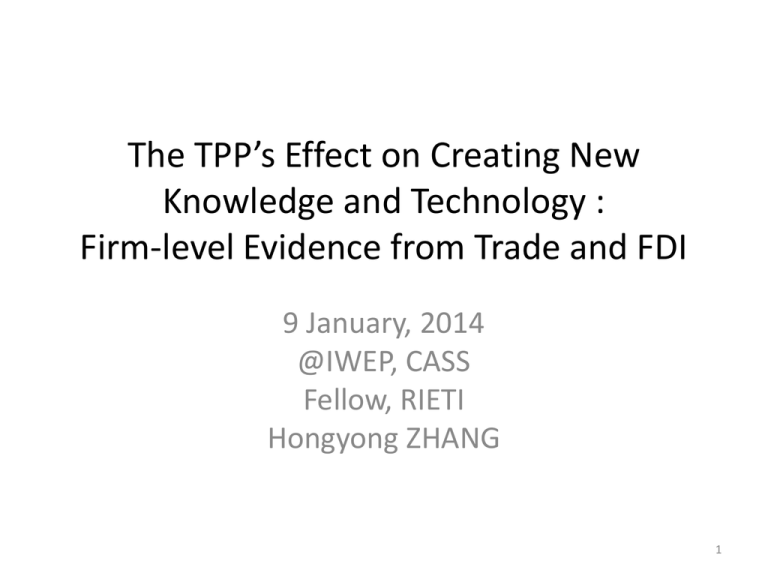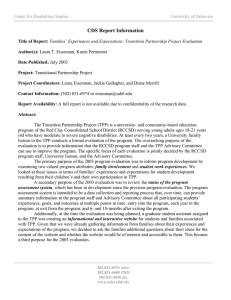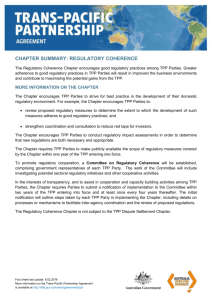The TPP’s Effect on Creating New Knowledge and Technology :
advertisement

The TPP’s Effect on Creating New Knowledge and Technology : Firm-level Evidence from Trade and FDI 9 January, 2014 @IWEP, CASS Fellow, RIETI Hongyong ZHANG 1 Estimating the TPP’s effects • Kawasaki (2013,RIETI) → Computable General Equilibrium (CGE) model of global trade → The income gains of the APEC economies as a whole would account for 1.2% of regional GDP from TPP. • Li and Whalley (2012,NBER) → Numerical five-country (China, US, Japan, other TPP countries, and rest of world) global general equilibrium model → Japan’s joining TPP would benefit both Japan and all other TPP countries, but negative effects on non-TPP countries; If China joins in TPP, it will increase all TPP countries’ gain. • Petri and Plummer (2012,PIIE) → CGE model and estimating FDI liberalization → If Japan and Korea take part in the TPP, Japan’s GDP in 2020 would be about 2% larger. • These estimates are based on macroeconomic models and focus on the direct effects of the TPP. → The TPP lowers barriers for trade and FDI → increasing export and investment→ increasing domestic production 2 • However, the TPP will not only temporarily increase GDP but also contribute to economic growth in the long run by sustainably promoting domestic innovation and technological improvement through globalization including trade and FDI. • These growth effects of the TPP are not fully recognized (Todo,2013,RIETI). → The TPP’s effect on creating new knowledge and technology is important. 3 The channels/mechanisms for creating new knowledge and technology • Learning by exporting • Knowledge spillovers from inward FDI • Other channels: Technology transfer through import etc. 4 Learning by Exporting empirical evidence: • Kimura and Kiyota (2006,RWE) for the case of Japan → a firm’s TFP increases by 2.4% when it starts to export, by 1.8% when it starts to conduct FDI. • Du, Lu, Tao, and Yu (2012,CER) for the case of China → domestic firms displayed significant productivity gains upon export entry. → the productivity gains were more pronounced in high- and medium-technology industries than in low-technology ones. • Blalock and Gertler (2004,JIE) for the case of Indonesia • De Loecker (2007,JIE) for the case of Slovenia. 5 Kimura and Kiyota (2006,RWE) for the case of Japan 6 Du, Lu, Tao and Yu (2012,CER) for the case of China 7 Knowledge spillovers from inward FDI empirical evidence: • Todo (2006,JAE) for the case of Japan → R&D stocks of foreign firms increase productivity of Japanese firms through knowledge spillovers. • Lin, Liu, and Zhang(2009,CER) for the case of China → FDI has generated beneficial vertical spillover effects to Chinese domestic firms. • Javorcik (2004,AER) for the case of Lithuania • Haskel, Pereira, and Slaughter (2007,RESts.) for the case of United Kingdom 8 Todo (2006,JAE) for the case of Japan 9 Lin, Liu and Zhang(2009,CER) for the case of China 10 Conclusion • The TPP has a large trade creation effect. • The TPP’s effect on creating new knowledge and technology is not negligible. • From the point of view of firms, the TPP alone is not sufficient. To Japan, EPAs with China, Korea, and the European Union (EU) are equally important. 11 Reference • Kawasaki, Kenichi (2013), “The Relative Significance of EPAs in Asia-Pacific," RIETI Discussion Paper, forthcoming. • Li, Chunding and John Whalley (2012), “China and the TPP: a Numerical Simulation Assessment of the Effects Involved,” NBER Working Paper 18090, May 2012 • Petri, Peter and Michael G. Plummer (2012), "The Trans-Pacific Partnership and Asia-Pacific Integration: Policy Implications," Peterson Institute for International Economics Policy Brief. • Todo, Yasuyuki (2013), “Estimation the TPP’s Expected Growth Effects,” RIETI Policy Update 048. • Kimura, Fukunari and Kozo Kiyota (2006), "Exports, FDI, and Productivity: Dynamic Evidence from Japanese Firms," Review of World Economics, 142(4), 615-719. • Du, Julan, Yi Lu, Zhigang Tao and Linhui Yu (2012), “Do domestic and foreign exporters differ in learning by exporting? Evidence from China,” China Economic Review, 23(2012), 296-315. • Blalock, G., and Gertler, P. (2004), “Learning from exporting revisited in a less developed setting,” Journal of International Economics, 75(2), 397-416. • De Loecker, J. (2007), “Do export generate higher productivity? Evidence from Slovenia,” Journal of International Economics, 73(1), 69-98. • Todo, Yasuyuki (2006), "Knowledge Spillovers from Foreign Direct Investment in R&D: Evidence from Japanese Firm-Level Data," Journal of Asian Economics, 17(6), 996-1013. • Lin, Ping, Zhuomin Liu, and Yifan Zhang (2009), “Do Chinese domestic firms benefit from FDI inflow? Evidence of horizontal an vertical spillovers,” China Economic Review, 20(2009), 677-691. • Javorcik, B.S. (2004), “Does foreign direct investment increase the productivity of domestic firms? In search of spillovers through backward linkages,” American Economic Review, 94, 605-627. • Haskel, J., Pereira, S., and Slaughter, M. (2007), “Does inward foreign direct investment boost the productivity of domestic firms?” Review of Economics and Statistics, 89, 482-496. 12




